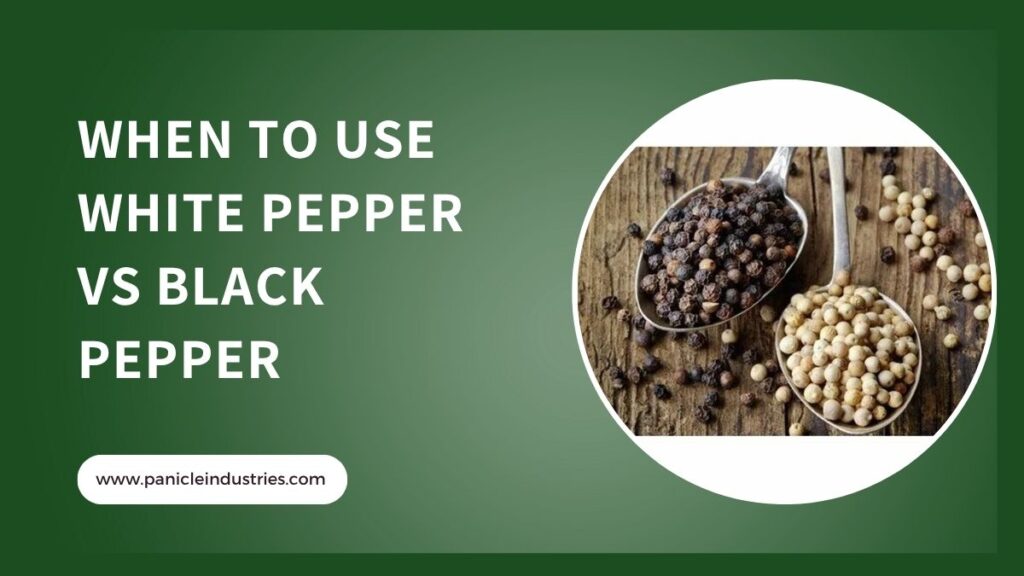Pepper is one of the most widely used spices in kitchens across the world. It adds flavor, warmth, and depth to countless dishes. However, many people often wonder: when to use white pepper vs black pepper? Though both come from the same plant, they are processed differently, which gives them unique flavors, colors, and uses. Black pepper is bold and pungent, while white pepper is milder with a subtle heat. Knowing the difference between the two can help you choose the right pepper for each dish and improve your cooking skills.
In this blog, we will explore the differences, benefits, and the right times to use white pepper and black pepper in cooking.
What is Black Pepper?
Black pepper is made from unripe peppercorns that are dried until the outer skin turns black and wrinkled. It is the most common type of pepper used worldwide and is often called the “King of Spices.” Black pepper has a sharp, strong flavor with earthy undertones. It is versatile and can be used in almost any savory dish, from soups and salads to meats and sauces. Because of its robust taste, black pepper is often preferred in recipes that need bold seasoning. It not only enhances the flavor but also brings warmth and aroma to dishes.
What is White Pepper?
White pepper comes from the same peppercorns as black pepper but is processed differently. After harvesting, the outer black skin of the peppercorn is removed, leaving only the inner seed. This gives white pepper a lighter color and a more delicate taste compared to black pepper. It has a slightly earthy flavor with a mild heat. White pepper is often used in dishes where a lighter color is desired, such as white sauces, creamy soups, or mashed potatoes. It blends into food without leaving black specks, which makes it popular in elegant or light-colored dishes.
Also read: Can White Pepper Be Substituted for Black Pepper
Key Differences Between White Pepper and Black Pepper
Although they come from the same plant, their processing creates noticeable differences.
- Flavor – Black pepper is bold, spicy, and aromatic. White pepper is milder and less pungent.
- Color – Black pepper leaves visible dark specks in dishes, while white pepper blends in.
- Processing – Black pepper is dried with its skin, while white pepper is soaked and stripped of its outer layer.
- Culinary use – Black pepper suits hearty dishes, while white pepper is best for light-colored or delicate recipes.
- Aroma – Black pepper has a strong, earthy fragrance, while white pepper offers a subtle, fermented scent.
When to Use Black Pepper
Black pepper is the more versatile of the two and works well in many cooking situations. You should use black pepper when:
- Seasoning meats – Perfect for steaks, chicken, or lamb because of its bold flavor.
- Enhancing soups and stews – Adds depth and heat to rich, hearty dishes.
- Spicing vegetables – Works well with roasted or sautéed vegetables.
- Adding to sauces – Especially tomato-based or brown sauces that need strong flavor.
- Everyday cooking – Ideal for scrambled eggs, sandwiches, or stir-fries.
Black pepper is the spice you can sprinkle on almost anything when you want a strong and aromatic taste.
When to Use White Pepper
White pepper shines in situations where flavor is needed without the dark specks of black pepper. You should use white pepper when:
- Making white or creamy sauces – Such as béchamel or Alfredo, to keep the sauce looking smooth.
- Cooking mashed potatoes – Blends in naturally without changing the color.
- Flavoring light soups – Especially cream-based or chicken soups where a mild spice works better.
- Asian cuisine – White pepper is often used in Chinese, Thai, and Vietnamese dishes for subtle heat.
- Egg dishes – Works well in omelets or custards where appearance is important.
White pepper is excellent for dishes where you want seasoning but not the dark specks of black pepper.
Health Benefits of Black Pepper
Black pepper is not only flavorful but also offers health benefits:
- Rich in antioxidants that fight free radicals.
- Improves digestion by stimulating stomach acid.
- Enhances nutrient absorption in the body.
- Has anti-inflammatory properties.
- May help in weight management by boosting metabolism.
Adding black pepper to your meals regularly can make food more delicious and beneficial for health.
Health Benefits of White Pepper
White pepper also provides several health advantages:
- Aids digestion and improves appetite.
- Contains antioxidants that support overall health.
- Has anti-inflammatory effects that may ease joint pain.
- Provides mild relief from cough and cold.
- Supports metabolism and weight management.
Though its flavor is lighter, white pepper still carries nutritional and medicinal benefits similar to black pepper.
Mistakes to Avoid When Using White and Black Pepper
Many people use pepper incorrectly. Here are common mistakes to avoid:
- Using one type for all recipes – Learn when to use white or black pepper for best results.
- Adding pepper too early in cooking – This can make it lose flavor; add it towards the end.
- Not storing properly – Exposure to air reduces pepper’s aroma; keep it in airtight containers.
- Using pre-ground pepper – Freshly ground pepper has stronger flavor and aroma.
- Over-seasoning – Pepper should enhance flavors, not overpower them.
Avoiding these mistakes will help you get the best taste from your pepper.
White Pepper vs Black Pepper in Global Cuisines
Different cuisines around the world prefer one type over the other:
- European cuisine – Black pepper dominates in hearty meat dishes and stews.
- Asian cuisine – White pepper is common in Chinese hot soups and stir-fries.
- French cooking – White pepper is used in light sauces for a smooth appearance.
- Indian cuisine – Black pepper is widely used in curries, spice blends, and snacks.
- Modern fusion cooking – Chefs experiment with both for unique flavor balance.
This shows that both peppers have a global importance and different roles in cooking traditions.
Which One Should You Choose?
The choice between white pepper and black pepper depends on your dish and taste preference:
- Choose black pepper if you want bold, strong flavors that stand out.
- Choose white pepper if you want mild heat and a clean look in light-colored dishes.
In many kitchens, having both types of pepper is the best solution. This allows you to experiment and pick the right one for each meal.
Conclusion
Understanding when to use white pepper vs black pepper can greatly improve your cooking and enhance the flavors of your dishes. While black pepper is bold, pungent, and ideal for hearty meals, white pepper is subtle, smooth, and perfect for light-colored or delicate recipes. Both not only add taste but also bring health benefits, making them valuable spices in everyday cooking.
By knowing their differences, using them at the right time, and avoiding common mistakes, you can elevate simple meals into flavorful experiences. Keeping both peppers in your kitchen ensures you always have the right spice for the right dish.


